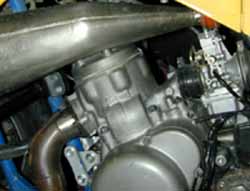Two-Stroke Engine Basics: Part Three
 Yesterday we overviewed the main process that takes place in the cycle of a two-stroke engine. Now we are going to breakdown this process a little further to better understand what is occurring in this process. When the piston is working in its cycle, the crankshaft will give the piston momentum so that it can return to the spark plug for the compression stroke. During this process the piston compresses the mixture of Yamalube oil, fuel and air to create a vacuum, which in turn opens the reed valve and draws in more of this mixture from the carburetor.
Yesterday we overviewed the main process that takes place in the cycle of a two-stroke engine. Now we are going to breakdown this process a little further to better understand what is occurring in this process. When the piston is working in its cycle, the crankshaft will give the piston momentum so that it can return to the spark plug for the compression stroke. During this process the piston compresses the mixture of Yamalube oil, fuel and air to create a vacuum, which in turn opens the reed valve and draws in more of this mixture from the carburetor.
Once the cycle is completed, the piston will fire again and repeat the process. The fact that there are two strokes—the compression and the combustion—is how the engine gets its name. Because the piston accomplishes so many tasks, the two-stroke engine so lightweight and versatile. Tomorrow we will review some of the major pros and cons of the two-stroke engine.

